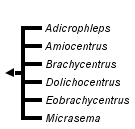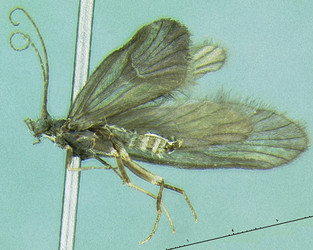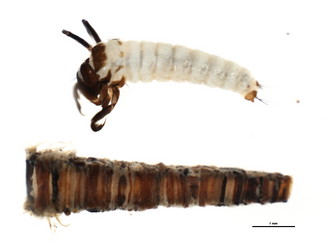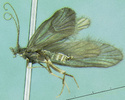Brachycentridae
Ralph W. Holzenthal, Roger J. Blahnik, Aysha Prather, and Karl Kjer


This tree diagram shows the relationships between several groups of organisms.
The root of the current tree connects the organisms featured in this tree to their containing group and the rest of the Tree of Life. The basal branching point in the tree represents the ancestor of the other groups in the tree. This ancestor diversified over time into several descendent subgroups, which are represented as internal nodes and terminal taxa to the right.

You can click on the root to travel down the Tree of Life all the way to the root of all Life, and you can click on the names of descendent subgroups to travel up the Tree of Life all the way to individual species.
For more information on ToL tree formatting, please see Interpreting the Tree or Classification. To learn more about phylogenetic trees, please visit our Phylogenetic Biology pages.
close boxIntroduction
This is a Northern Hemisphere family found in both the Old and New Worlds. Ulmer (1903) originally established this group as a subfamily of Sericostomatidae. It now contains 6 genera and a little over 100 species. Three of these genera are monotypic: Adicrophleps Flint (Nearctic), Amiocentrus Ross (Nearctic), and Dolichocentrus Martynov (southeastern Siberia). Eobrachycentrus Wiggins (Japan and western North America) contains only half a dozen species. Brachycentrus Curtis (ca. 30 species) and Micrasema McLachlan (ca. 75 species) are both widespread across the Holarctic and Oriental regions. Larvae construct cases from plant or rock materials, and some species use silk alone for part of the case. Several genera build 4-sided cases. The family is ecologically diverse. They inhabit running waters, but may be found in slow-flowing marshy channels. Some genera feed on aquatic moss; others are filter-feeders. Larvae of some Brachycentridae have rows of hairs on the middle and hind legs used for filtering food particles from currents. Some North American species of Brachycentrus can be found in thermal streams with temperatures as high as 34°C that smell strongly of hydrogen sulfide (Wiggins 2004). (From Holzenthal et al., 2007)
References
Holzenthal et al., 2007 R.W. Holzenthal, R.J. Blahnik, A.L. Prather and K.M. Kjer, Order Trichoptera Kirby, 1813 (Insecta), caddisfles, Zootaxa 1668 (2007), pp. 639–698.
Ulmer, G. (1903) Ueber die Metamorphose der Trichopteren. Abhandlungen des Naturwissenschaftlichen vereins in Hamburg, 18, 1–154.
Wiggins, G.B. (2004) Caddisflies: the underwater architects. University of Toronto Press, Toronto, 292 pp.
Title Illustrations

| Scientific Name | Micrasema burksi |
|---|---|
| Specimen Condition | Dead Specimen |
| Sex | Male |
| Life Cycle Stage | Adult |
| View | Lateral |
| Source Collection | Barcode of Life Database (BOLD) |
| Scientific Name | Brachycentrus sp. |
|---|---|
| Specimen Condition | Dead Specimen |
| Life Cycle Stage | Adult |
| View | Lateral |
| Source Collection | Barcode of Life Database (BOLD) |
About This Page
Ralph W. Holzenthal

University of Minnesota, St. Paul, Minnesota, USA
Roger J. Blahnik

University of Minnesota, St. Paul, Minnesota, USA
Aysha Prather

Centre for Biodiversity and Conservation Biology, Royal Ontario Museum, Toronto, Ontario, Canada
Karl Kjer

Rutgers University, New Brunswick, New Jersey, USA
Correspondence regarding this page should be directed to Ralph W. Holzenthal at , Roger J. Blahnik at , Aysha Prather at , and Karl Kjer at
Page copyright © 2010 Ralph W. Holzenthal, Roger J. Blahnik, Aysha Prather, and Karl Kjer
 Page: Tree of Life
Brachycentridae.
Authored by
Ralph W. Holzenthal, Roger J. Blahnik, Aysha Prather, and Karl Kjer.
The TEXT of this page is licensed under the
Creative Commons Attribution-NonCommercial-ShareAlike License - Version 3.0. Note that images and other media
featured on this page are each governed by their own license, and they may or may not be available
for reuse. Click on an image or a media link to access the media data window, which provides the
relevant licensing information. For the general terms and conditions of ToL material reuse and
redistribution, please see the Tree of Life Copyright
Policies.
Page: Tree of Life
Brachycentridae.
Authored by
Ralph W. Holzenthal, Roger J. Blahnik, Aysha Prather, and Karl Kjer.
The TEXT of this page is licensed under the
Creative Commons Attribution-NonCommercial-ShareAlike License - Version 3.0. Note that images and other media
featured on this page are each governed by their own license, and they may or may not be available
for reuse. Click on an image or a media link to access the media data window, which provides the
relevant licensing information. For the general terms and conditions of ToL material reuse and
redistribution, please see the Tree of Life Copyright
Policies.
- First online 17 July 2010
- Content changed 20 July 2010
Citing this page:
Holzenthal, Ralph W., Roger J. Blahnik, Aysha Prather, and Karl Kjer. 2010. Brachycentridae. Version 20 July 2010 (under construction). http://tolweb.org/Brachycentridae/14606/2010.07.20 in The Tree of Life Web Project, http://tolweb.org/









 Go to quick links
Go to quick search
Go to navigation for this section of the ToL site
Go to detailed links for the ToL site
Go to quick links
Go to quick search
Go to navigation for this section of the ToL site
Go to detailed links for the ToL site